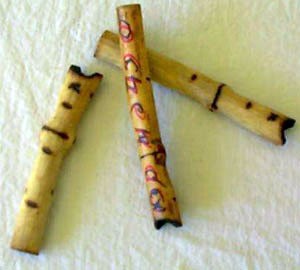Resource 6: Musical pipes
![]() Background information / subject knowledge for teacher
Background information / subject knowledge for teacher

Adapted from: Motherland Music, Website
The Oja flute or pipe hails from eastern Nigeria and is often used with other drums such as Ekwe, Udu and Igba. This unique whistle talks while the drummers are playing. During the masquerade dancing in eastern Nigeria, the Oja flute will lead the drums and praise the music and dance. The Oja player has the ability to use several words. The dancers move to the tune of the Oja flute as if it were a drum. If an important person appears or enters the room, the Oja player will use the flute to announce the name of that person. The Oja flute is also played at home without other instruments, or while strolling with one's partner in the evening.
The Oja flute is a piece of wood designed with a cavity inside, the top has a wide opening to fit the shape of the human lower lip, a small hole on the bottom and two smaller holes closer to the top on exact opposite sides. The musician blows the musical sounds through the wide opening, while placing the thumb and the ring fingers simultaneously on the two smallest holes to control the rhythm. The bottom hole, which is left alone at all times, controls the musical rhythm outflow. The Oja flute is used to accompany dances and songs, or is played as a solo instrument.
Making and playing your own pipes
Pipe ensembles are special music groups because each person plays only one note. However, put together, often in very complicated ways, this creates wonderful music.
Pipes can be made from reeds (in rural areas) or metal (in urban areas). Pipe length can vary from 20 cm to over 1 m, producing a range of high and low notes.
You can make your own pipes by using plastic piping such as electrical conduit, cutting plastic fax-paper pipes, or irrigation piping (12–15 mm diameter). Make pipes of different lengths so that you have different notes.
To play the pipes:
- Place the open side of the instrument level, against the lower lip.
- Hold the pipe between your fingers, the index and thumb.
- Relax your other fingers around the middle of the instrument.
- Begin to blow softly across the hole until a note is produced.
- Experiment with closing the bottom of the pipe with your hand.
You could also use different sized bottles and blow across the tops to produce sounds.
Resource 5: Pupil praise songs



